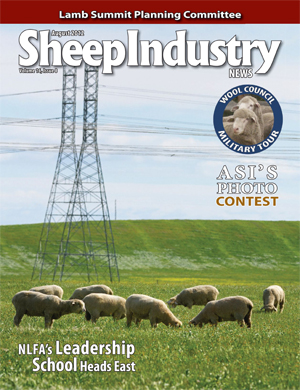
- August 2012
- 2012 ASI Conducting Photo Contest
- MSU Plays Host to Wool Council and Military
- NLFA Leadership School Goes to the East Coast
- Vilsack Announces New Disaster-Relief Policies
- Sheep Grazing Goes Urban
- Simpson Pulls Bighorn Language
- Lamb Summit Planning Committee
- More Slaughter Plants Needed for Locally Sourced Meat
MSU Plays Host to Wool Council and Military
By JUDY MALONE
ASI Director of Industry Information
(August 1, 2012) Wool is sustainable. Wool is a high-performance natural fiber. Wool is a renewable resource.
These were the take-home messages from the 2012 Wool Education Seminar held in Bozeman, Mont., July 10-12. The American Sheep Industry Association’s (ASI) American Wool Council (AWC), in conjunction with its summer meeting, hosted military personnel from the U.S. Marine Corps, U.S. Army and the U.S. Special Operations Command spotlighting wool performance characteristics and giving attendees a chance to see the industry that grows the miracle fiber.
The U.S. military continues to be the largest domestic consumer of American wool, using about 20 percent to 25 percent of the annual wool clip. It is important for them to not only understand where the wool comes from but also to know how it will perform for soldiers. The focus of the education portion of the tour was to educate about and advocate for the use of wool for military apparel.
“We in the sheep business are also in the education business today,” says Larry Pilster, chair of the American Wool Council. “We are responsible for building connections from the producer end of the scale.”
According to Mitch Driggers, ASI military wool consultant, “The military offices we deal with many times have little or no experience with wool, particularly as performance fabrics. Seminars like this one give the AWC the opportunity to provide education about wool and its countless uses.
“We do have a fiber which is truly versatile and natural,” he adds.
Driggers, working with Rodney Kott, Ph.D., extension sheep specialist with Montana State University (MSU), presented an overview of the structure of wool and how its natural properties translate into a good choice for military use. It is fire resistant because of its high moisture and nitrogen content, is naturally anti-microbial as well as stain repellant because of the fiber’s fatty cuticle layer and is easy to alter because of its coiled molecular structure giving high elongation and excellent recovery abilities.
Learning exactly why wools natural characteristics make it is so suitable for textiles and military use was very informative for the military attendees who seek many of these capabilities inherently available in wool.
“I learned a lot about wool in terms of the length of wool, the micron count, the regions where sheep are raised and the impact each of these factors has on the type of wool that is used for garments and clothing,” says one military attendee. “This seminar helped me to understand why wool performs the way it does and what the industry is doing in terms of genetics to improve the performance.
“When you look at performance parameters, wool gives us tremendous capability. I see so much potential here to make U.S.-grown, U.S.-produced products,” he continues.
Dialogue also included a demonstration of the objective measurement equipment used with wool, a display of fleeces in a range of different microns for participants to compare and a review of the projects currently being developed and tested.
With the recent introduction of the superwash equipment into the United States, the Wool Council has been proactive in developing high-tech wool products that offer both protection and comfort to our military personnel – washable wool underwear that meets military needs, durable socks that wick away moisture and new fire-retardant fabrics for protective clothing. This equipment has led to a resurgence by domestic manufacturers to buy, process and spin U.S. wool right here in the United States providing for a 100-percent American product.
“Sharing the wonders of wool with our vital U.S. military is a privilege and responsibility,” says Rita Kourlis Samuelson, ASI wool marketing director, summing up the event. “We appreciate the opportunity to better understand the needs of the military and develop wool products that meet those needs. I am also pleased that attendees have now had a chance to better understand the commitment and dedication of the U.S. producers to the natural, high-performance fiber that is wool.”
Another business priority of the AWC included the recommendation of the 2012-2013 fiscal year Wool Trust budget to ASI’s Executive Board for final approval by ASI’s Board of Directors.
MSU is home to one of two wool labs in the United States and the staff of the lab provides critical research and support services to wool producers through its three-pronged mission statement of service, education and research. Grab and core sampling comparisons, fiber distribution and density and fleece weight uniformity are just a few of the research project being conducted at the MSU Wool Lab.
While in Montana, the council also met with the Sweet Grass County Wool Marketing Association in Big Timber, visited MSU’s Fort Ellis Research Farm, toured the MSU Residual Feed Intake sheep barn, met with MSU President Cruzado and had dinner with elected officials, among other things.

